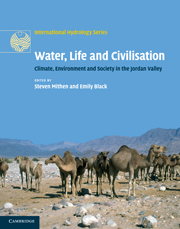Book contents
- Frontmatter
- Contents
- List of figures
- List of tables
- List of contributors
- Acknowledgements
- 1 Introduction: an interdisciplinary approach to Water, Life and Civilisation
- Part I Past, present and future climate
- Part II The palaeoenvironmental record
- Part III Hydrological studies of the Jordan Valley
- Part IV Human settlement, climate change, hydrology and water management
- 14 The archaeology of water management in the Jordan Valley from the Epipalaeolithic to the Nabataean, 21,000 BP (19,000 BC) to AD 106
- 15 From global climate change to local impact in Wadi Faynan, southern Jordan: ten millennia of human settlement in its hydrological context
- 16 Palaeoenvironmental reconstruction at Beidha, southern Jordan (c. 18,000–8,500 BP): Implications for human occupation during the Natufian and Pre-Pottery Neolithic
- 17 The influence of water on Chalcolithic and Early Bronze Age settlement patterns in the southern Levant
- 18 Modelling water resources and climate change at the Bronze Age site of Jawa in northern Jordan: a new approach utilising stochastic simulation techniques
- 19 A millennium of rainfall, settlement and water management at Humayma, southern Jordan, c. 2,050–1,150 BP (100 BC to AD 800)
- Part V Palaeoeconomies and developing archaeological methodologies
- Part VI Society, economy and water today
- Part VII Conclusions
- Index
- Plate section
- References
19 - A millennium of rainfall, settlement and water management at Humayma, southern Jordan, c. 2,050–1,150 BP (100 BC to AD 800)
from Part IV - Human settlement, climate change, hydrology and water management
Published online by Cambridge University Press: 26 April 2011
- Frontmatter
- Contents
- List of figures
- List of tables
- List of contributors
- Acknowledgements
- 1 Introduction: an interdisciplinary approach to Water, Life and Civilisation
- Part I Past, present and future climate
- Part II The palaeoenvironmental record
- Part III Hydrological studies of the Jordan Valley
- Part IV Human settlement, climate change, hydrology and water management
- 14 The archaeology of water management in the Jordan Valley from the Epipalaeolithic to the Nabataean, 21,000 BP (19,000 BC) to AD 106
- 15 From global climate change to local impact in Wadi Faynan, southern Jordan: ten millennia of human settlement in its hydrological context
- 16 Palaeoenvironmental reconstruction at Beidha, southern Jordan (c. 18,000–8,500 BP): Implications for human occupation during the Natufian and Pre-Pottery Neolithic
- 17 The influence of water on Chalcolithic and Early Bronze Age settlement patterns in the southern Levant
- 18 Modelling water resources and climate change at the Bronze Age site of Jawa in northern Jordan: a new approach utilising stochastic simulation techniques
- 19 A millennium of rainfall, settlement and water management at Humayma, southern Jordan, c. 2,050–1,150 BP (100 BC to AD 800)
- Part V Palaeoeconomies and developing archaeological methodologies
- Part VI Society, economy and water today
- Part VII Conclusions
- Index
- Plate section
- References
Summary
ABSTRACT
Humayma is an extensive archaeological site located in the hyper-arid region of southern Jordan. It was principally occupied between the Nabataean and early Islamic periods, c.100 BC to 800 AD, and provides evidence for the most complex water management system known outside of Petra. Since 1986 John Oleson has led extensive survey and excavation at Humayma, documenting the hydraulic structures and examining the various settlement remains that include a Nabataean cultic centre, Roman fort and early Islamic qasr. By making estimates of annual precipitation, surface runoff, water storage capacity and the extent of cultivated land, he has recently proposed that a total of 448 persons, 3,008 ovicaprids and 300 camels or donkeys could have been sustained within the Humayma catchment. This chapter draws on Oleson's research to develop a water balance model for Humayma to further explore the relationship between rainfall, runoff, storage capacity, agriculture and population levels. To do so, it reviews the textual and archaeological evidence for the settlement, undertakes an evaluation of the site's catchment using remote-sensing and digital elevation modelling, and then undertakes multiple simulations of the hydrological and hydraulic systems under a range of rainfall scenarios. Its results are in broad agreement with Oleson's estimates for past population levels, although various additional constraints on population are highlighted. Overall, a more thorough understanding of the hydrological dynamics of Humayma is developed.
- Type
- Chapter
- Information
- Water, Life and CivilisationClimate, Environment and Society in the Jordan Valley, pp. 302 - 334Publisher: Cambridge University PressPrint publication year: 2011
References
- 1
- Cited by

